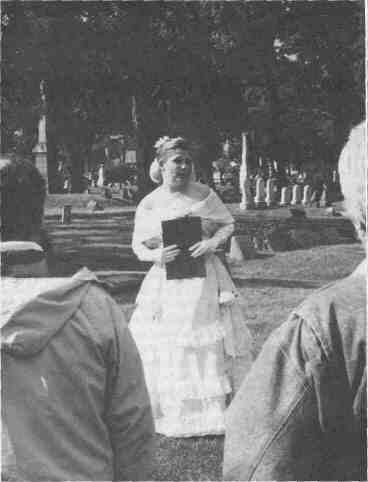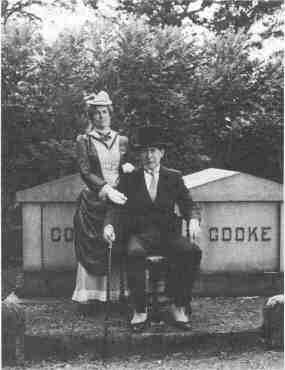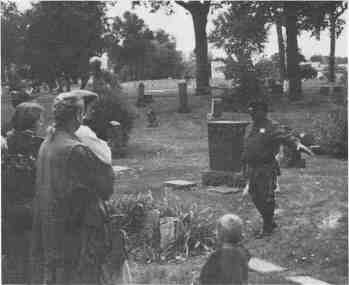SPECIAL FOCUS
Cemetery Walks
This is no ordinary walk in the park. Waukegan Park District takes its residents on a stroll through the local cemetery and area history.
BY CARRIE SMITH
|

Waukegan
resident Carolyn Jackson portrays
travelling singer Clara
E. Baker at
Waukegan Park District's 1996
Oakwood Cemetery Walk.
|
Years ago, people used cemeteries more often as
parks. Besides being a site to visit lost loved ones,
people also thought of the cemetery as a nice place to
take walks, a peaceful setting to read a book and a
great place for a picnic.
Once again, people are beginning to appreciate the
park-like setting, peaceful environment and beautiful
monuments that these older cemeteries have to offer.
Who hasn't driven or walked by one, wondering who
lies under those elaborate gravestones and vaults?
One way people learn about the cemeteries and
their residents is through cemetery walks, which are
quickly growing in popularity along the East Coast
and throughout the Midwest. A cemetery walk is
much more than a brief tour of the grave sites of a
town's early prominent settlers. A cemetery walk is a
trip to the past in which participants experience
history with the help of costumed actors and
reenactments.
Why hold a cemetery walk? A cemetery walk can
connect people with their town's history and
consequently build pride in the community. It can
provide a positive exchange among generations who
participate as volunteers or audience members. Also,
it creates awareness and enthusiasm for historical
restoration and preservation of historic buildings and
the cemetery monuments.
In 1995, the Waukegan Park District joined efforts
with the Waukegan Historical Society and the city of
Waukegan to hold its first cemetery walk, "The
|
July/August 1997 /35
Oakwood Cemetery Walk." Since then, the walks
have been held annually with more than 400
participants who have learned about Waukegan's
history and gained a deeper appreciation for the
cemetery.
Waukegan's cultural arts specialist, Sharon
Laughlin, and a committee of volunteers have
worked many hours in planning this special event
each year. Along the way they have experienced
challenges and obstacles they are willing to share
with others who want to coordinate such event.
Determining the Date, Time,
Site and Transportation
Oakwood Cemetery Walk has always been
scheduled on a Saturday afternoon in September
(with a rain date on the following Saturday).
September is a good time because summer programs
have ended, families are no longer on vacation
because school has started, and the weather is still
mild. A cemetery walk should not be too close to
Halloween or people may associate it with ghosts and
spookiness, rather than the positive, educational
event it is meant to be. The walk is held on Saturday
afternoons because people are willing to go out after
a morning of errands and household chores.
The location may be an easy decision, especially in
smaller communities where only one historic
cemetery exists. Larger cities like Waukegan or
Skokie that have several older cemeteries to choose
from may feature a different cemetery yearly.
One hurdle the Waukegan Park District faced was
the inadequate parking near the cemetery. Other
communities may have the same problem since the
historic cemeteries tend to be located in areas that
were developed before cars were invented. The
solution may be to invite people to come to another
site, such as a park or facility, and transport them to
the cemetery.
"Bowen Park is a natural choice to begin the
event," says Laughlin.
"We have plenty of parking there. Plus, the
historic Haines Museum is in the park We are able
to open up the museum for tours and feature
exhibits in Bowen Park's other facilities."
Since the Park District asks people to meet about
two miles from Oakwood, school buses transport the
visitors to the cemetery.
"Cemetery Portraits," a walk held in September
by the Arlington Heights Historical Society, also
offers bus transportation for its nearly 100 visitors
from its museum to the nearby Wheeling Township
Arlington Heights Cemetery. According to Susan
English, Arlington Heights Historical Museum
coordinator, the society also offers "History Alive" at
the Historical Museum every other March for those
who are unable to go to the cemetery. History Alive
features the same costumed actors and characters at
the museum that are seen at their September event.
At the first Oakwood Cemetery Walk, when
Laughlin did not know how many people would
come, she advertised three bus departure times, but
took no reservations. Most people came early hoping
to board on the first bus trip. Laughlin's solution was
to have buses run back and bring more people for
extra tours. She observed that the crowd dwindled
later on during the event.
The second year, the Waukegan Park District
knew about how many people to expect. The
committee lined up several buses, calculating about
how many people each could hold. Once again, most
people came early, but things ran much more
smoothly. A ticket was made for each bus seat
available for each trip. The first people to arrive
received blue tickets for the first tour. When those
ran out, people were given yellow tickets for the
second tour, and green tickets for the third tour.
Laughlin also learned that people need to know
the schedule for when the buses leave Bowen Park
and Oakwood Cemetery. After the very first cemetery walk was over, Laughlin received a call from
some rather frantic patrons. They had wandered off
to the other side of the large cemetery, and when
they came back, everyone else was gone. Laughlin
had to drive back to the cemetery and pick up the
stranded visitors. To make sure nobody is left behind,
Laughlin now makes sure there is a large sign posted
at the park and at the cemetery, listing the departure
times. The bus tickets also list departure times.
Choosing Subjects
There are more than 4,000 graves at Oakwood
Cemetery, so it is hard to narrow down whom to
feature each year. Some things the committee
considers are location, prominence and diversity.
Because of the cemetery's large size, one tour
cannot encompass the entire area. Laughlin and the
committee choose a section of the cemetery and a
tour path. Characters are chosen based on their
location with the path.
Laughlin limits the number of characters to five or
six. She feels that more speakers would make the
walk too long and tiring. In some cases, two actors
may portray friends or relatives at the grave site.
They can either take turns speaking to the crowd or
have a dialogue between the two of them as the
audience listens.
It is important to ensure diversity among the
characters. Finding information about specific
women and minorities is challenging, because
historically they have been ignored for many years.
Some women features at Oakwood Cemetery Walk
36/ Illinois Porks and Recreation
have included: the wife of an early mayor; Sarah Fay
Milner, the principal of one of the first schools;
Beatrice Pearce, the first female physician in the city;
Clara E. Baker, a singer who traveled with the family
troupe before the Civil War.
Thanks to the participation of James Dorsey, Lake
County's expert on local African-American history,
visitors have learned more about little-known aspects
of minorities in Waukegan. Dorsey, a local sociology
professor researches local African-American history as
a hobby. He has portrayed Green Tarver, the first
permanent African-American settler in the city and
George Washington Bell, a former slave turned Civil
War soldier.
People like to hear about familiar names, so the
walk includes prominent historical characters for
which streets, schools and parks have been named
after.
Featuring a special theme can help narrow down
the choice of characters. This year the Historic Elgin
Cemetery Walk is focusing on the Civil War, so all
characters have some connection with that time
period. Still, Elgin's cemetery is so large and the
choices so many that the walk offers the choice of
touring two "loops" at different parts of the cemetery, the first in the morning and the second in the
late afternoon.
Costumes
Costumes can set the event apart from simpler
cemetery tours, but keep in mind the following
considerations.
"The clothes worn by the interpreters at a historic
site can either add to or detract from the credibility
of the whole site," says writer Nancy Torgerson in
the January 1996 issue of the IMHS (Association of
Illinois Museums and Historical Studies) Technical
Leaflet.
Research is essential to ensure that the costumes
accurately reflect the time period being portrayed,
the socioeconomic level of the characters and the
location of the site. Torgerson mentions three
companies that specialize in historical patterns (see
sidebar on page 38.). Old photographs of the
characters being portrayed can be very helpful, too.
Costumes can come from a number of sources
including local theater companies, costume rentals,
loans from individuals and even from the volunteers
themselves.
Laughlin has built-in help because the Waukegan
Park District has its own theater company. She was
able to borrow costumes for tour guides from Bowen
Park Theatre Company. Ken Kauzlarik and Laurie
Joseph, the company's costumcrs, got the volunteers'
measurements, found appropriate costumes to rent
and altered them when necessary.
Carolyn Jackson, a Waukegan resident who
volunteered to portray the singer Clara Baker, opted
to make her own costume. She found four mint
green bridesmaids dresses at local thrift stores. She
cannibalized them to create a new gown similar to
the one that Baker wore in a family photograph.
Besides photographs, historical documents such as
diaries, newspaper articles and local histories, may
also provide clues
for dressing
actors. Local
brewer William
Besley was
known to wear a
grey stovepipe
hat, so Kauzlarik
made sure that
actor Hank Clark
wore a similar hat
when he portrayed Besley
last year.
Hillside
Cemetery Walk
in Palatine
features props,
such as period
tables, chairs and
lamps to enhance
the costumes,
says Marilyn
Pedersen,
museum
coordinator of
Clayson House.
|

Dan Drury plays Homer
Cooke and Billle Kocal portrays
Sally Ann Simmons Cooke at
Waukegan Park District's 1996
cemetery walk.
|

James Dorsey, lake County's expert on
local African-American history,
portrays George Washington Bell,
a former slave and soldier in the
Civil War.
|
July/August 1997 /37
Volunteers
Volunteers are essential to create a successful
cemetery walk. Oakwood Cemetery Walk relies on
approximately 35 volunteers.
Each year Laughlin has advertised for volunteers in
the Waukegan Park District's program magazine and
through news releases in the newspapers as early as
February. She also has called upon the members of
the Waukegan Historical Society.
For special expertise, she personally asks individuals to participate. Genealogist Ann Darrow is trying
to document who and where everyone in the
cemetery is buried, so Laughlin has asks for her help
every year. Laughlin personally asked Dorsey to be an
actor because of his extensive knowledge of African American history.
Besides actors and tour guides, many volunteers
are needed to make sure people board the right
buses, attend the exhibits, hand out promotional
flyers for other living history events, serve refreshments and hand out informational booklets.
After the buses arrive at Oakwood Cemetery, a
costumed greeter welcomes the visitors. The greeter
gives a brief history of the cemetery and assigns
people to one of five or six costumed tour guides.
The tour guides start at different spots along the tour
path and work their way either clockwise or counterclockwise. Several actors may be performing
simultaneously for different tour groups to make the
most of the limited time allowed at the cemetery.
(Time is limited because of the bus schedules.)
Other Entertainment
Other features of the cemetery walk enhance the
experience while guests are waiting for the tours to
begin. For example, at the Lilac Cottage next door
to the Haines museum, posters and a slide show
teach participants about cemetery symbolism and
preservation. Visitors also look at displays of old
family photographs and documents, such as advertisements of the family business and diaries, from die
individuals who are features on the walk.
An attractive souvenir booklet can give interesting
information about gravestone symbolism, brief
biographies about the characters being portrayed and
personal information about the actors. Last year, the
Waukegan Historical Society hosted a mock Victorian-era wake at the Haines Museum. A mannikin in
an antique casket lay in the parlor while two female
actors in black lace lamented that their "sister"
Angelina died of typhoid.
Gravestone rubbing, a Victorian-era hobby, is
growing in popularity again. Laughlin joined the
Association for Gravestone Studies (see sidebar
below) so she could receive information about
gravestone rubbing and buy a special plaster casting
of a gravestone. Volunteers showed visitors how to
make gravestone rubbings last year.
Music can help set the mood for a Cemetery Walk.
Playing music by the exhibits is one option. Last
year, Audrey Siwula played the Autoharp and sang
period songs at Oakwood Cemetery before people
divided into tour groups. Even the actors may want
|
Cemetery Walk Resources
Association for Gravestone Studies (AGS)
c/o Rosealee OaJdey, Registrar
19 Hadley Place
Hadley, MA 01035
413.584.1756
Association of Illinois Museums and
Historical Societies (AIMHS)
Illinois State Historical Society
1 Old State Capitol Plaza
Springfield, IL 62701
The Wisconsin State Old Cemetery Society
Dan Buckman, Inscriptions Editor
3334 West Grant Street
Milwaukee. WI 53215
414.384.1001
The Handbook of English Costume in the Nineteenth Century
by C. Willett Cunnington & Phillis Cunnington
New York: Dover Publications, Inc., 1990
American Victorian Costume in
Early Photographs
by Priscilla Harris Dalrymple
New York: Dover Publications, Inc., 1991
Past Patterns
P.O. Box 7587
Grand Rapids, MI 49510
Amazon Vinegar and Pickling Works Drygoods
(Historic Patterns)
2218 East llth Street
Davenport, IA 52803-3760
Raiments
(Historic Patterns)
P.O. Box 93095
Pasadena, CA 91109
— Resources and upcoming cemetery walk
Information compiled by Carrie Smith
|
38/ Illinois Parks and Recreation
to sing or play instruments if it is relevant to their
characters.
One year. Hillside Cemetery Walk featured a
horse-drawn hearse carrying an antique coffin. In
keeping with the Civil War theme this year, visitors
to the cemetery walk in Elgin will be treated to a
Civil Way Reenactment.
After a long journey back in time, visitors will be
tired and thirsty, so it is always good to have
refreshments available.
Funding
It costs appropriately $3,000 to put on Oakwood
Cemetery Walk, so Laughlin relies on sponsors to
help fund it. Local education organizations, such as
the local library and community college have been
good sources. The city of Waukegan has also helped
provide funds, transportation and security for this
event.
One consideration is whether to charge admission.
Oakwood Cemetery Walk has been free thanks to
sponsorship from other organizations. The Arlington
Historical Society charges admission for Cemetery
Portraits to cover transportation and security costs.
Hillside Cemetery Walk charges a small fee to help
pay for replacing damaged or missing headstones.
Local businesses also may help. At Oakwood's first
walk, grocers donated cider and donuts. A funeral
home loaned the antique casket for the mock wake.
"Just be sure [to] credit your sponsors for their
help," advises Laughlin. "Mention sponsors on
signs, in promotions and in any booklets given out
at the event." •
CARRIE SMITH
is the communications specialist for ihe Woukegan Park District.
July/August 1997 /39


